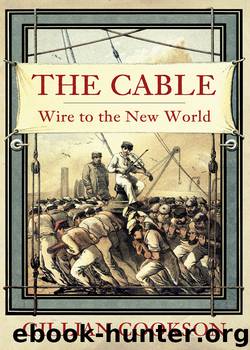The Cable by Gillian Cookson

Author:Gillian Cookson
Language: eng
Format: epub
ISBN: 9780752488004
Publisher: The History Press
Published: 2012-09-19T16:00:00+00:00
seven hundredweight strain sufficed to keep the rate of the cable near enough to that of the ship, but as the water deepened the proportionate speed of the cable advanced, and it was necessary to augment the pressure by degrees, until, in the depth of 1,700 fathoms, the indicator showed a strain of 15 hundredweight [three quarters of a ton] while the cable and ship were running five and a half and five knots respectively.
By noon, with the vessel 214 miles from shore, and having laid 255 miles of cable, there was an increasing swell and a strong breeze. Morse, who held a watching brief for the US government, ‘had to retire to his berth as soon as the elements asserted themselves, and was scarcely visible again till all was over’.
After this, with the depth approaching 2,000 fathoms, about two miles, the strain had to be increased to a ton. ‘At six in the evening’, said Bright, ‘some difficulty arose through the cable getting out of the sheaves of the paying-out machine, owing to the tar and pitch hardening in the grooves, and a splice of large dimensions passing over them.’ Bright managed to retrieve the situation by fitting extra guards to the machine, and removing the congealed tar with oil. While this work was in progress, laying had to be halted, the cable temporarily held by stoppers until it could be re-attached to its pulleys. Bright considered this to be a significant achievement, ‘showing that it is possible to lay in deep waters without continuing to lay out cable – a point upon which doubts have been frequently expressed’. This had been an anxiety beforehand, as the ‘vast strength and grip of machinery’ needed to support the weight of cable at depth had caused problems in the Mediterranean.
But then the cable started to run away at a speed much faster than that of the ship. The vessel had slowed to three knots, but the cable was leaving at five and a half or more. The wind and sea meanwhile increased their force, and the task was complicated by a current which carried the cable at an angle from the ship’s course. The brake, or retarding force, had to be increased to 25, then 30, and finally 35 hundredweight, or one and three quarter tons, as the cable issued forth at a speed ‘more than it would have been prudent to permit’.
The cable’s progress was slowed to five knots, when in the early hours of 11 August, with 335 miles laid and in 2,000 fathoms, it snapped. Bright, who had been attending to the brakes himself, was sure that matters were under control and briefly left the scene to check the speed of the ship and to see how the cable was emerging from the hold. In the moments he was away, the machine was left in the charge of an experienced mechanic, one who ‘had been from the first engaged in its construction and fitting’. This man, though, failed to release the brakes to compensate for the ship’s descent in the swell.
Download
This site does not store any files on its server. We only index and link to content provided by other sites. Please contact the content providers to delete copyright contents if any and email us, we'll remove relevant links or contents immediately.
| American National Standards Institute (ANSI) Publications | Architecture |
| History | Measurements |
| Patents & Inventions | Research |
Whiskies Galore by Ian Buxton(41863)
Introduction to Aircraft Design (Cambridge Aerospace Series) by John P. Fielding(33064)
Small Unmanned Fixed-wing Aircraft Design by Andrew J. Keane Andras Sobester James P. Scanlan & András Sóbester & James P. Scanlan(32743)
Craft Beer for the Homebrewer by Michael Agnew(18140)
Turbulence by E. J. Noyes(7934)
The Complete Stick Figure Physics Tutorials by Allen Sarah(7307)
Kaplan MCAT General Chemistry Review by Kaplan(6865)
The Thirst by Nesbo Jo(6825)
Bad Blood by John Carreyrou(6542)
Modelling of Convective Heat and Mass Transfer in Rotating Flows by Igor V. Shevchuk(6391)
Learning SQL by Alan Beaulieu(6208)
Weapons of Math Destruction by Cathy O'Neil(6138)
Man-made Catastrophes and Risk Information Concealment by Dmitry Chernov & Didier Sornette(5920)
Digital Minimalism by Cal Newport;(5661)
Life 3.0: Being Human in the Age of Artificial Intelligence by Tegmark Max(5472)
iGen by Jean M. Twenge(5365)
Secrets of Antigravity Propulsion: Tesla, UFOs, and Classified Aerospace Technology by Ph.D. Paul A. Laviolette(5309)
Design of Trajectory Optimization Approach for Space Maneuver Vehicle Skip Entry Problems by Runqi Chai & Al Savvaris & Antonios Tsourdos & Senchun Chai(5011)
Electronic Devices & Circuits by Jacob Millman & Christos C. Halkias(4906)
